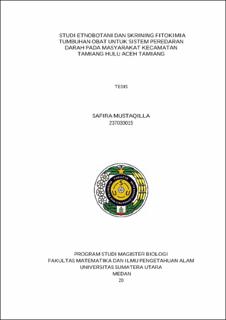| dc.description.abstract | The use of traditional medicinal plants plays an important role in maintaining
public health, particularly in the treatment of circulatory system diseases, which
remain a major health concern. This study aims to document the ethnobotanical
knowledge of the Tamiang Hulu community regarding the use of medicinal plants for
circulatory system disorders and to identify the phytochemical compounds contained
therein. The research methods employed were interviews with key informants, direct
observations, and visual documentation of the recorded medicinal plants. Data were
analyzed descriptively and qualitatively using an ethnobotanical approach,
complemented by the calculation of the Index of Cultural Significance (ICS) to
determine the level of importance of each plant based on community knowledge. The
results showed that 60 species of medicinal plants are utilized by the community to
treat various circulatory system diseases such as hypertension, diabetes, cholesterol,
stroke, anemia, and heart disease. Leaves were the most frequently used plant organ,
with decoction being the dominant method of preparation. The highest ICS value was
obtained for ginger (Zingiber officinale Roscoe). The main phytochemical
compounds identified included flavonoids, tannins, glycosides, and terpenoids. The
Tamiang Hulu community still possesses extensive knowledge regarding the use of
medicinal plants for maintaining circulatory system health; however, this knowledge
is at risk of declining among the younger generation. Therefore, the preservation of
local knowledge through documentation, education, and integration with modern
scientific research is essential, alongside the development of phytopharmaceutical
potential from local plants to support sustainable community health. | en_US |


